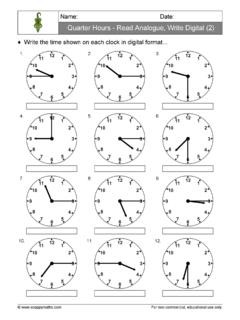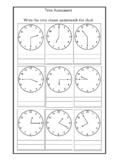Transcription of Common Entrance Assessment Specification - aqe.org.uk
1 Association for Quality Education Limited Common Entrance Assessment Specification AQE Limited Common Entrance Assessment Specification The content to be covered for the Common Entrance Assessment is matched exactly to the Northern Ireland Council for the Curriculum, Examinations and Assessment 's Specification for the 2007/2008 Transfer Tests, with the Science and Technology . element removed to take account of the Revised Curriculum. As a consequence, the Mathematics and English sections of Transfer Tests set in previous years, and existing Transfer Test practice materials (of high quality), can continue to be used in preparation for the Common Entrance Assessment .
2 English Questions will assess the AT2 Reading and AT3 Writing sections of the Programme of Study for English. The level of difficulty of the questions will not exceed that indicated by the level descriptions for Level 5. Mathematics Questions set will relate to the Key Stage 2 Programme of Study for mathematics. They will not assume a knowledge or understanding beyond this. The level of difficulty of the questions will not exceed that indicated by the level descriptions for Level 5. Questions will address content detailed in the Attainment Targets: Number;. Measures; Shape and Space; and Handling Data, as set out in the extracts from the Programme of Study reproduced below.
3 Where material has been omitted or where limitations have been put on specific content for the purposes of the tests, these have been indicated in bold text immediately following the particular section of the Programme of Study to which they relate. The nature of the Common Entrance Assessment is such that aspects of the Programme of Study that involve certain types of activity, such as discussion or practical activities, will not be included. The use of the calculator will not be permitted in the tests. As Processes in Mathematics pervades the entire mathematics programme, aspects of the strands of Using Mathematics, Communicating Mathematically, and Mathematical Reasoning will be included in questions, where appropriate.
4 While the use of the calculator is not permitted in the tests, questions relating to the interpretation of a calculator display may be included. Page | 2. NUMBER. Understanding number and number notation Pupils should have opportunities to: a read, write and order whole numbers, initially to 100 and progressing to using any whole number, understanding that the position of a digit signifies its value; use their understanding of place value to develop computational methods;. b extend understanding of place value to include decimals, initially to one decimal place and then up to two decimal places; use this to multiply and divide numbers by 10, 100, and 1000.
5 C estimate within calculations, initially with numbers within 100 and extending to all whole numbers; approximate numbers to the nearest 10 or 100; estimate and approximate to gain a feeling for the size of a solution to a problem, for example, understand that 32 9 is approximately 30 10;. d understand and use, in context, vulgar fractions, decimal fractions and percentages; understand the equivalence of simple fractions; explore the relationships between fractions and percentages, for example, understand that half price is the same as 50% off. Relationships other than those listed below will not be included in the tests: = = 50%. = = 25% . = = 75%. 1 = = 100%.
6 1. /10 = = 10%. = = 33 %. Patterns, relationships and sequences Pupils should have opportunities to: a explore and predict patterns and sequences of whole numbers initially within 100 and extending to larger numbers, including counting in different sizes of step, doubling and halving numbers, finding multiplication patterns in the Page | 3. hundred square, predicting subsequent numbers in a sequence; follow simple sets of instructions to generate a sequence;. Questions will not be set on devising rules for determining sequences b understand and use multiples and factors and terms including prime, square and cube; appreciate that multiplication and division are inverse operations.
7 C interpret, generalise and use simple relationships expressed in numerical, spatial and practical situations, for example, finding equivalent forms of two digit numbers; understanding square and triangular numbers; understand and use simple function machines;. d understand that a letter can stand for an unknown number, for example, 6 + a = 24. Questions will only involve the use of whole numbers and a letter will not be squared or cubed. Operations and their applications Pupils should have opportunities to: a consolidate knowledge of addition and subtraction facts to 20; understand and use this knowledge to calculate quickly facts that they cannot recall; add mentally two two-digit numbers up to 100 and subtract mentally one two- digit number from another; know the multiplication facts to 10 10; use these facts when solving problems.
8 B engage in a range of activities to develop understanding of the four operations of number and their interrelationships;. Questions will not be set on appreciation of the use of brackets develop a range of non-calculator methods of computation to include addition and subtraction with up to two decimal places and multiplication and division of decimals by whole numbers; use these operations to solve problems, using a calculator where necessary. Money Pupils should have opportunities to: a understand and use the conventional way of recording money; use the four operations to solve problems;. b estimate and approximate to gain a feeling for the size of a solution to a problem before carrying out a calculation.
9 Page | 4. c interpret a calculator display in relation to money. MEASURES. Pupils should have opportunities to: a develop skills in estimation of length, weight, volume/capacity, time, area and temperature through practical activities, using metric units where appropriate;. b develop the language associated with a wider range of metric units and be confident with the terms metre, gram and litre, and their relevant prefixes of kilo, centi, milli;. c appreciate important ideas about measurement including the continuous nature of measurement and the need for appropriate accuracy;. d choose and use appropriate metric units and measuring instruments in a variety of situations, interpreting numbers on a range of measuring instruments, for example, measure the perimeter of the playground to the nearest metre using a trundle wheel.
10 E understand the relationship between units, for example, know that kilograms and grams are used to weigh food; convert from one metric unit to another, for example, know that 175 centimetres is metres; use the four operations to solve problems, working with up to three decimal places, where appropriate;. Pupils will not be expected in the test to know the Imperial units still in Common use f understand and use negative numbers in context, for example, know that if the temperature rises during the day from -3 C to 4 C, the temperature has risen by 7 degrees;. g understand the concept of perimeter and calculate the perimeter of simple shapes; find areas by counting squares and volumes by counting cubes.


